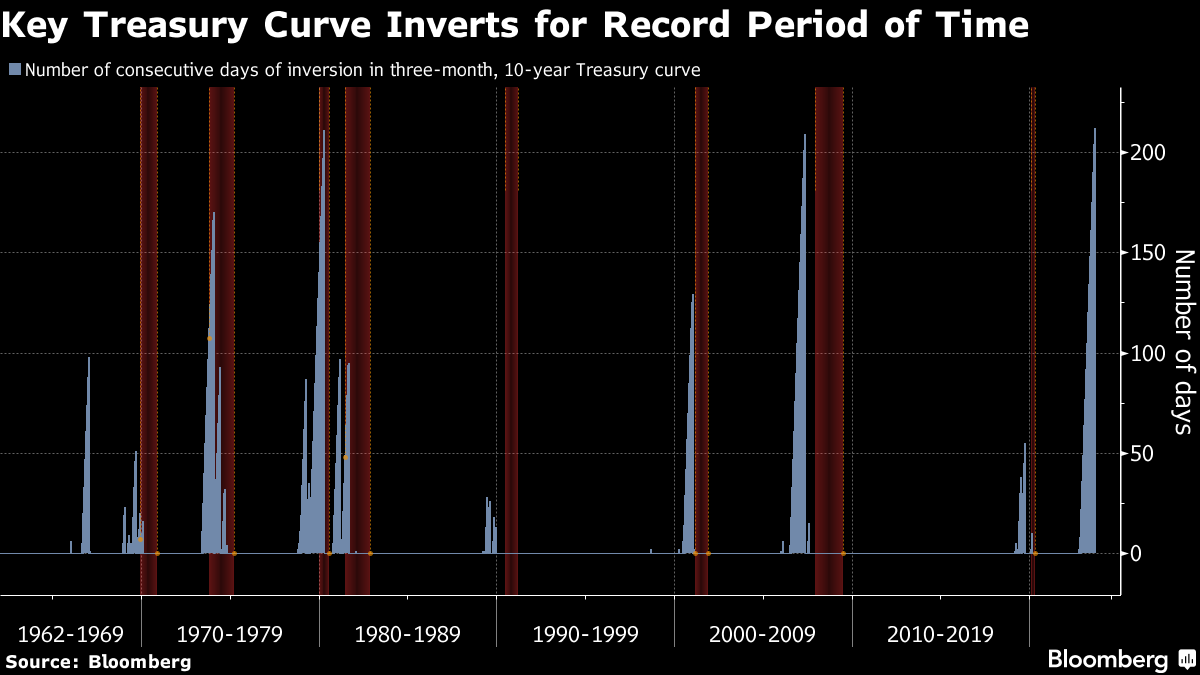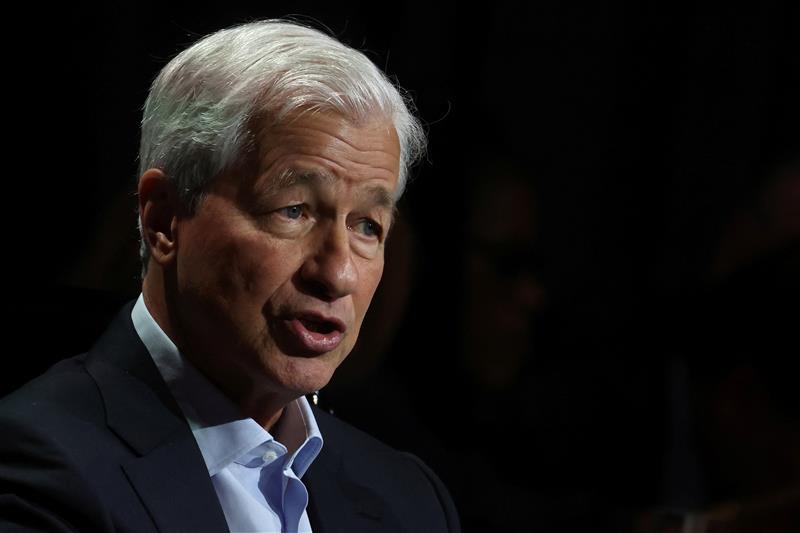- The inverted yield curve on U.S. Treasuries has been flashing warnings about the economy for some time now.
- 10-year yield has been below the 3-month rate for 212 trading days.
- Such an inversion telegraphed the last eight recessions. And on Sept. 14, the market surpassed the 1980 record to hold that way for the longest consecutive daily stretch since Bloomberg’s records begin in 1962.
- Campbell Harvey, the Duke University economist who pioneered the use of the yield curve as a recession indicator, said its predictive power remains intact. “The inverted yield curves have forecast eight of the last eight recessions — without a false signal,” he said in an email. “Ignore the signal at your own risk.”
The United States bond market hasn’t flashed recession warnings so consistently for so long in at least six decades.
On Wall Street and in Washington, optimism may be building that the U.S. Federal Reserve is poised to steer the economy toward a soft landing.
But for 212 straight trading days, no matter what the indicators have said, the Treasury market has delivered what is widely understood as a starkly different message: The economy is veering toward a contraction, since 10-year yields have held below three-month ones.
Such an inversion telegraphed the last eight recessions. And on Sept. 14, the market surpassed the 1980 record to hold that way for the longest consecutive daily stretch since Bloomberg’s records begin in 1962.

The apparent disconnect between the market’s warning and the surprisingly resilient economy shows how much uncertainty has persisted since the Fed started its aggressive rate hikes in March 2022.
In October, when the three-month to 10-year segment of the yield curve inverted, the vast majority of economists surveyed by Bloomberg predicted a recession would come by this year. Yet the U.S. economy has continued to expand. A closely watched measure from the Federal Reserve Bank of Atlanta even shows it’s gaining steam.
“This cycle has been an odd one, because when the yield curve originally inverted, most expected we were on the verge of a downturn,” said Phillip Wool, head of research at Rayliant Global Advisors Ltd. “The surprising strength of the U.S. economy makes the odds of a soft landing much better than they were a year ago. But it’s nowhere close to a guarantee.”
An inversion of the yield curve is a leading indicator of a slowdown because it shows expectations the central bank will be easing policy in the future to jump-start growth.
But that signal may be distorted by the scale of the Fed’s tightening so far, which has pushed up its benchmark short-term rate by more than five percentage points, the steepest increase since the early 1980s.
So while the Fed could ease next year, it may be because policymakers react to cooler inflation, rather than the need to fight a recession, an outcome economist Ed Yardeni has called the “Nirvana scenario.”
The futures market expects its benchmark rate to end 2024 around 4.4 per cent, well above the 2.5 per cent that policymakers generally consider neutral to growth. In recessions, central banks typically cut rates below the neutral level.
Still, the inverted yield curve can be a self-fulfilling prophecy. That’s in part because its successful track record may cause businesses and consumers to cut back, seeing it as an accurate predictor of trouble ahead.
It also ripples through the credit system by giving banks less incentive to extend loans, since they borrow at short-term rates and lend at long-term ones. Recently the yield from a portfolio divided 60 per cent to 40 per cent between stocks and bonds was less than just investing in three-month Treasury bills, according to data compiled by Bloomberg.
“A thriving finance-based economy cannot do well if low-risk investments yield higher than high-risk investments,” Bill Gross, former chief investment officer of Pacific Investment Management Co., said in a recent interview with Bloomberg Television.
While some forecasters, including those at Goldman Sachs Group Inc., have dialled back the probability of a recession, many still expect one. Forecasters surveyed by Bloomberg put the probability at 60 per cent, with most expecting it next year.
Moreover, the yield curve sometimes inverts long before a contraction. In July 2006, the 10-year yield started holding consistently below the three-month rate, but the downturn didn’t start until December 2007. By then, the Fed was already cutting rates and long bond yields had pushed back over short ones.
Campbell Harvey, the Duke University economist who pioneered the use of the yield curve as a recession indicator, said its predictive power remains intact.
He has focused on the average level of inversion over months instead of the number of consecutive days. By that measure, the recent spell doesn’t look particularly long. His tally shows it was inverted over a 15-month period before the recession that started at the end of 2007 and for 18 months ahead of the one in the 1980s.
“The inverted yield curves have forecast eight of the last eight recessions — without a false signal,” he said in an email. “Ignore the signal at your own risk.”
— With assistance from Cameron Crise and Sarina Yoo
Story by Ye Xie - Redacted bullet points by Jody Davis https://financialpost.com/investing/bond-market-recession-alarms-as-economy-remains-defiant and https://www.bloomberg.com/news/articles/2023-09-14/the-bond-market-has-never-sounded-recession-alarms-for-this-long




